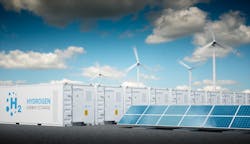Has Battery Storage Become the Silver Bullet So Many Claim?
According to the Wood Mackenzie U.S. Energy Storage Monitor's Q4 report, the expected utility procurements, regulatory changes and grid-related developments will result in annual market deployment of 3,900 MW of storage capacity by 2023 and the market value of this development will be US$4.5 billion. This prediction represents very healthy growth since the latest actual annual deployment was 215 MW in 2017 and the preliminary number for 2018 is about double the 2017 figure. Does the growth we are seeing and this forecast indicate that battery storage has become the silver bullet for the electric sector as many claim?
It depends on who one speaks to. The U.S. Energy Storage Monitor (ESM) report found that nearly 60% of the installed capacity growth in the market during Q3 2018 was behind-the-meter (BTM). The authors attributed this growth to ongoing solar-plus-storage demand by customers seeking greater resiliency and those responding to changes in net metering and utility tariffs. Some analysts viewing the cup as half empty suggest the reason for reduced growth in the front-of-the-meter (FTM) segment relates to restrictions in the wholesale markets that prevent capture of the full value of energy storage. However, in longer term, the ESM authors believe that the FTM sector will overcome these hurdles and be the major driver for the energy storage growth anticipated during the next few years. State-driven regulatory programs, large utility procurements and grid service opportunities are expected to contribute to this growth. Implementation of rules in organized ISO markets as per FERC Order 841 will further assist energy storage development in wholesale markets.
Much of the energy storage growth to date has been driven by programs and projects in a limited number of states with California, Hawaii and New York leading the list for the last several years. That said, an increasing number of states are requiring utilities to incorporate battery storage into their planning and such demand pressure facilitates price reductions. GTM Research estimates lithium-ion battery storage prices were in the area of US$207/kWh in 2018 and that the price will decline about 8 percent per year over the next four to five years. Part of the rationale for the price decline is greater production with the expected startup of a number of major battery manufacturing facilities. Targray, a multinational specialty materials company, has identified 10 giga-factories, i.e. battery plants with a capacity of at least 1 GW, that are expected to come on line within the next several years. Targray also projects that utilities will be increasingly motivated to partner with or acquire solar-based energy storage system (ESS) companies. Among the drivers that are making ESS companies and their projects look attractive to utilities are the declining battery storage costs, more proven technology with LI-solar packages, and more creditworthy project opportunities with lower merchant risk and more secure revenue generation.
So is our opening question answered? Recent results from utility competitive procurement proceedings involving solar and LI battery ESS would make it appear so. Prices in Hawaii have been in the range of US$0.08 to US$0.12/kWh for long-term solar plus storage contracts. Agreements in the western U.S. have reached levels below US$0.04/kWh for LI-solar ESS power purchase contracts. However, this is a bit misleading because kWh provided by LI storage alone would be about 10 times more expensive than a system with solar and battery backup.
The less-competitive price for the battery component of the equation was reinforced by a recent study performed to determine the optimal approach for achieving Minnesota’s 70% renewables goal. Researchers found it would be more cost effective to build excess solar capacity and accept periodic curtailment than to add storage capability. The study sponsors emphasized that storage will be an important component of a high renewables future; storage simply is not yet more competitive for power supply than other options.
The advancements in battery storage have also led to increasing claims that it is a competitive substitute for peaking capacity. Is this the case today? Researchers from NREL studying the CA energy market have found that the addition of battery storage actually changes the shape of the peak demand curve, so the answer is not straight-forward. Also, as one might expect, incremental additions of intermittent renewable solar capacity also change the relationship. Some analysts have concluded that solving peak demand requirements in “duration slices” can bolster the applications where battery storage is competitive.
The advancements in battery storage, both in terms of cost reductions and performance, are compelling. While cases exist that illustrate battery storage may not be “the” silver bullet as of yet, it is gaining ground as an option for helping utilities address load shifting, peak shaving, voltage control, regulation and more power functions which contribute to reliability, resiliency, cost control and emission reduction.
About the Author
David Shadle
Grid Optimization Editor
Dave joined the T&D World team as the editor of the Grid Optimization Center of Excellence website in January 2016.
Dave is a power industry veteran with a history of leading environmental and development organizations, championing crucial projects, managing major acquisitions and implementing change. Dave is currently a principal at Power Advance, LLC, an independent consulting firm specializing in power project development, research and analysis, due diligence and valuation support. Dave is also a contributing consultant for Transmission & Distribution World. Prior to Power Advance, Dave held business and power project development positions with The Louis Berger Group, Iberdrola Renewables, FPL Energy and General Public Utilities. He is a graduate of Pennsylvania State University, the New Jersey Institute of Technology and Purdue University.
